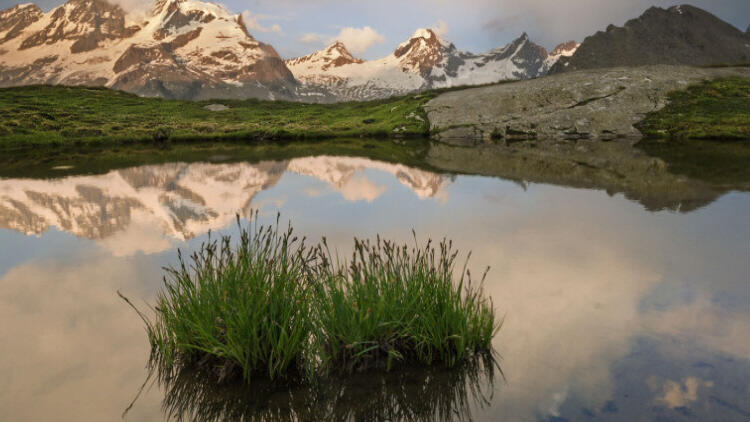Ibex. Chamois. Ermine. Grouse. Red foxes. As a teen, Stefano Unterthiner spent countless hours observing these animals in Gran Paradiso National Park, an hour or so drive from his home in Italy. His uncle Paolo, a passionate nature lover and photography buff, would take hikes with his best friend, Luciano, a park ranger, and invite Stefano along. Together they explored the forests and valleys of this pristine piece of the Italian Alps, looking for wild animals to photograph. Stefano’s first wildlife pictures were taken with an old film camera Paolo lent him. “I really fell in love with nature in that park. I really fell in love with photography in that park.” These experiences had a strong impact on his decision to study the natural sciences and eventually earn a Ph.D. in zoology before committing full time to wildlife photography. “It was a very special area … like my little Yellowstone,” he says.
“Rourounette,” the nickname Stefano’s wife, Stephanie, gave to this female red fox roughly translates to “red red one.” “This was the first autumn I spent in the park,” Stefano says. “At that time of year, the park is almost empty. There are no tourists around. I wanted to get a picture with the fox and the color. The fox was looking sleepy, like a dog. I was very close with a wide angle. It was a very special moment with a wild animal in the forest.”
A bearded vulture (Gypaetus barbatus) soars in Gran Paradiso
National Park.
A pair of foxes engages in aggressive interaction, which is more common in the early winter as the mating season approaches—but rare to witness.
Stefano recently spent more time with his beloved foxes during a yearlong assignment photographing in Gran Paradiso for National Geographic—which, he says, turned out to be one of the most difficult assignments he has done in terms of finding fresh views of a place so imprinted on his soul. Now that he is shooting digitally (Fred was shot on film), he was able to observe a wider range of behaviors, particularly in low-light situations. “Usually foxes are quite solitary,” he says. “During the assignment, I had the chance to see two or three foxes together—interacting, fighting, courtship behaviors—something very difficult to see, even for a fox specialist like me,” he laughs. “I think you can have a stronger relationships with some animals than others,” he says when asked to define the connection he feels with foxes. “It is easier to have a bond with foxes than mountain goats [or with giant Komodo dragons, I interjected, referring to our conversation on Proof a while back.]. There is a kind of empathy you can have with some species. The key point is trusting each other.” And how does he create this trust?
An Alpine chamois (Rupicapra rupicapra) stands against a mountain backdrop in Gran Paradiso National Park, Valle d’Aosta, Italy.
“If you read books about wildlife photography, they tell you you have to hide yourself. I do it the completely opposite way. I want the animal to know I am there. I dress myself in red sometimes. I want to be completely visible. When I get something it’s because I have a relationship with them. It breaks down the barrier, and then I become invisible again. But they know I am there. I am invisible because they don’t care.”
In cold weather, a normally reddish brown ermine changes into its white winter coat.
“It’s something you have to know how to do,” he continues, careful to highlight this method of approaching animals as part of an overall ethos—and a deep understanding of animal behavior—rather than simply a way to get a photograph. “The most important thing is to approach them in a way that you are not disturbing the animal, you are not consuming their energy, you are not feeding the animal, you are not touching them … This is the way I do it whenever I can, but this is not just with photography. This is the kind of relationship I want to have with other creatures, with my wife, with my friends.”
















